KRISTIN MCNEALUS, PT, DPT
2019 EP GUIDE - NAVIGATING SPECIAL NEEDS RESOURCES
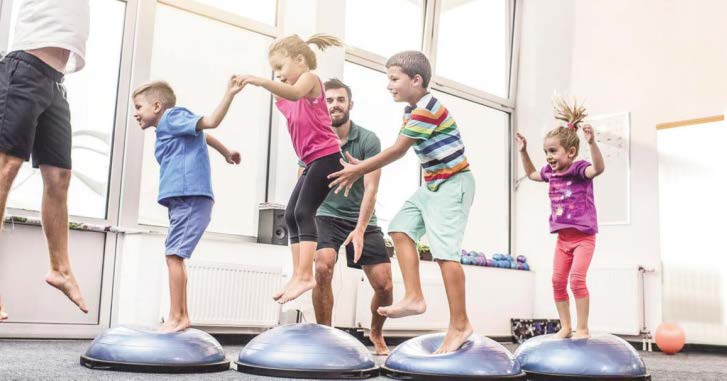
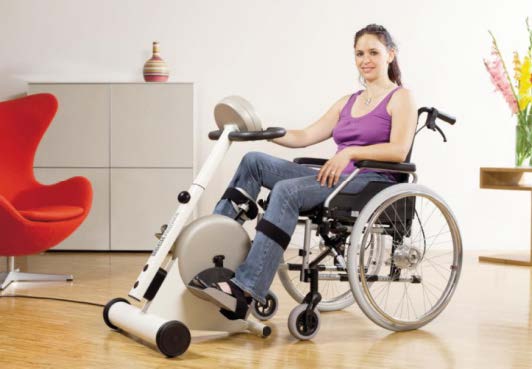
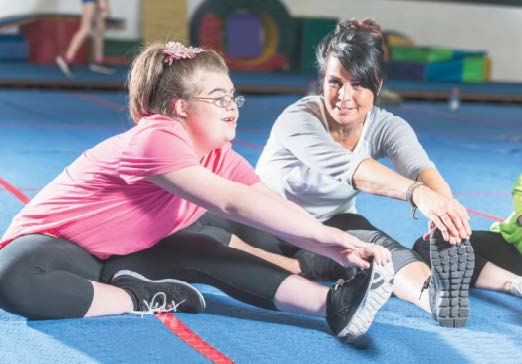
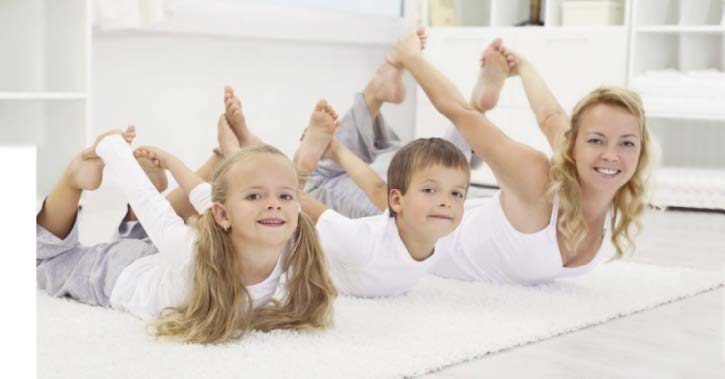
2019 Fitness Resources for People with Special Needs
Special Needs The CDC says that obesity rates for adults with disabilities are approximately 57% higher than adults without disabilities. This is based on BMI (Body Mass Index) measurements. Does that get your attention? They also state that children with disabilities have obesity rates that are 38% higher than children without disabilities.
Obesity contributes to more health complications, which can mean a lower quality of life, and hospitalizations. With the changing health care system, this could cost more money. Prevention is always less costly than treatment, so staying active can save money.
It is important for all people to engage in physical activity, even if there are special needs. The physical activity should include both aerobic exercise for heart health, as well as strengthening exercise, to build muscle, keep bones healthy and boost metabolism. If a person's needs make exer cise challenging, it is still important to not be inactive. Physical activity has also been shown to improve mood, and decrease stress. Hopefully these resources can be used by everybody in the family to get moving.
The recommendation for all adults is the same; if any special needs limit the ability to get the recommended amount and/or intensity, do whatever is possible – aiming for the goals. Aerobic exercise is sustained activity, such as walking, dancing, or cycling. And intensity matters! While you need to be able to keep the activity going continuously, if you are not pushing yourself into a zone that is stressing the body, you will not get the benefits. Think of a scale of 1 to10, where 10 is an all-out sprint, you want your aerobic exercise to be in a 46 /10. If you are working at a 4/10, it is recommended that you get 2 hours and 30 minutes of working out per week. If you push yourself to a 6/10 for your activity, you can get the recommended exercise in 1 hour and 15 minutes per week. Resistance activity is needed for strengthening. And it is recommended that this gets incorporated twice per week. This exercise needs to be performed at a higher intensity, at 7-9/10 on that scale. And bouts of work can be performed with periods of rest and recovery. Here is an easy-to-follow guide for all adults to be active: health.gov/paguide- lines/2008/pdf/adultguide.pdf
It is actually recommended that children and adolescents get 60 minutes of physical activity daily. This will promote healthy growth and bone health. On the other end of the spectrum, it is important that older adults add exercises that improve balance to their routines to ward off the risk of falls.
Getting children to be active can be encouraged by including friends or siblings. Find activities that are fun for your child. Some children may enjoy playing in the pool while others may like a playground better. Be sure to be active yourself, which will set a good example. Then include your children in your exercise routine!
When we think about getting exercise, we may think of going to a gym, or taking a fitness class. But there are many options out there, so it may take some time and effort to try a variety of activities to see what you and your children enjoy. There are activities that individuals can do alone for those of us who like to use workout time as a way to focus or clear the mind. There are activities that can be done together for family members who have special needs with those who do not, and then there are activities that people may enjoy doing among others with similar abilities. Do not limit yourself (or your family members) to only one type of workout. Look into all types. If you have children who do not have special needs playing team sports, look for local sports teams for your child with special needs. They can cheer each other on without competing with each other.
It can still be difficult to get started. First, you should make sure that your physician has cleared you for exercise. Then you may try to seek out a physical therapist for some guidance. You do not need to have a PT by your side for exercise, but one can help you decide the best workouts for you, explore local options, and educate you on what to be cautious about with exercise. Physical therapists are experts in how the body moves, and you can find one who specializes in pediatrics or who specializes in the condition that causes the limitation. If you want help finding a physical therapist, go to the American Physical Therapy Association website at apta.org and choose "Find a PT" at the top of the page.
The National Center on Health, Physical Activity, and Disability is a wonderful source for people with a disability to find resources regarding exercise. Per their site, NCHPAD seeks to help people with disability and other chronic health conditions achieve health benefits through increased participation in all types of physical and social activities, including fitness and aquatic activities, recreational and sports programs, adaptive equipment usage, and more. They offer a directory that provides links for programs available to people with disabilities by state, as well as organizations that can help people find local inclusive activities and/or adapted sports. There is a separate youth section for activities specifically geared toward children with disabilities. The NCHPAD also offers a directory of equipment companies that supply exercise, fitness, or sports equipment for people of all abilities. These are also organized by state. There is a directory of personal trainers who self-report expertise of working with the special needs population. Visit nchpad.org/Directories.
If you would like to find local individuals who maintain active American College of Sports Medicine (ACSM) certification or registry status, you can follow this link: certification2.acsm.org/profinder
The US Department of Health and Human Services has the President's Council on Sports, Fitness, and Nutrition, whose mission is to increase sports participation among youth of all backgrounds and abilities and to promote healthy and active lifestyles for all Americans. They started a program I Can Do It! (ICDI) which is a customizable and inclusive health promotion model aimed at transforming the lives of individuals with a disability. ICDI is centered on MentorMentee relationships and weekly healthrelated goals. In ICDI programs around the country, ICDI Mentors (aged 16+) and ICDI Mentees (participants with a disability aged five+) meet weekly to engage in physical activity, learn and practice healthy eating behaviors, and set health-related goals. Click on hhs.gov/fitness/programs-and-awards/i-can- do-it/index.html. If you cannot find an I Can Do It! program in your area, there is information about how to start one.
Is your child receiving physical education at school? Federal law mandates that physical education be provided to students with disabilities and defines Physical Education as the development of: • physical and motor skills • fundamental motor skills and patterns (throwing, catching, walking, running, etc.) • skills in aquatics, dance, and individual and group games and sports (including intramural and lifetime sports) The APE (Adapted Physical Education) teacher is a direct service provider, not a related service provider, because physical education for children with disabilities is a federally mandated component of special education services [U.S.C.A. 1402 (25)]. This means that physical education needs to be provided to the student with a disability as part of the special education services that child and family receive. This is contrasted with physical therapy and occupational therapy, which are related services. These therapies are provided to the child with disabilities only if he/she needs them to benefit from instruction. If you want more information about getting your child adapted physical education, further resources can be found at pecentral.org/adapted/adaptedmenu.html
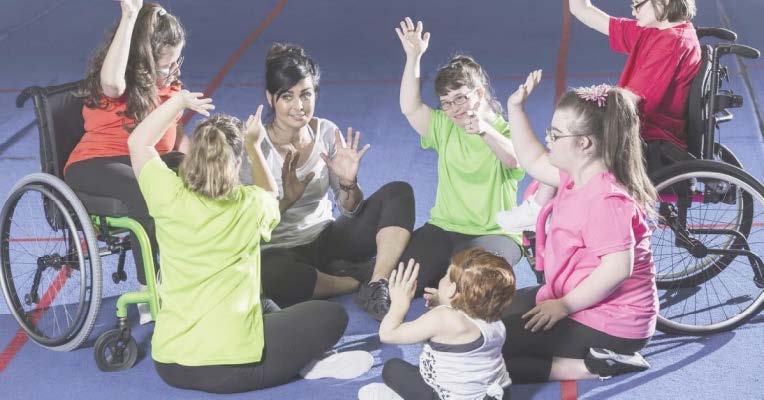
The Christopher and Dana Reeve Foundation provides resources for people who are newly paralyzed, people who are living with paralysis, parents and caregivers. They offer a resource center that can help you find any activity you may be interested in trying: christopherreeve.org/living-with-paraly- sis/health/staying-active . There are videos to give easy tips about how to be healthier, and links to local organizations.
The Arthritis Foundation offers a six week program called Walk With Ease. It is designed to teach you how to safely make physical activity a part of your daily activity. Walk with Ease aims to reduce pain and discomfort of arthritis, improve balance, increase strength, and increase walking pace. There is also a goal of building confidence and improving health. You can choose to follow the program in a self-guided fashion or a community-based format. arthritis.org/living-with-arthritis/tools-resources/walk- with-ease/about.php
The Adaptive Sports Center is in Colorado, and it is a full-fledged therapeutic recreation program that operates year round with a variety of adaptive activities. They work with people of all abilities. Check them out: adaptivesports.org
No Barriers is a program that offer experiences to trial adapted outdoor adventures and listen to speakers who are working to advance the technology available for recreation. nobarriersusa.org
If you have limb loss, you can look to the Amputee Coalition for guidance on how to stay active. amputee-coalition.org/limb-loss-resource-center
The Arc is an organization geared toward people with intellectual and developmental disabilities, and aims to support inclusion and participation in the community. thearc.org
Jared Ciner started SPIRIT Fit and Health in Maryland that is a certified personal trainer as well as a Disability Support Counselor. He suggests that the five top exercises for people in this population to perform regularly are: 1. Planks to strengthen the core 2.High knees to strengthen the hips and the back 3.Arm circles to strengthen the upper back 4. Single leg stands to improve balance and reduce the risk for falls 5. Squats to strengthen the legs
Another organization that we are familiar with for people with intellectual ability is the Special Olympics. The mission of Special Olympics is to provide year-round sports training and athletic competition in a variety of Olympic-type sports for children and adults with intellectual disabilities. This gives them continuing opportunities to develop physical fitness, demonstrate courage, experience joy and participate in a sharing of gifts, skills and friendship with their families, other Special Olympics athletes and the community. You can visit their website to find a local chapter and get involved in a variety of activities. specialolympics.org
There are activities for the visually impaired as well. With some research, people with impaired vision can participate in nearly every activity. Contacting the United States Association for Blind Athletes can get you started. usaba.org
Through the VisionAware website, you can learn more about rowing, martial arts, running, downhill skiing and cross-country skiing, sailing and boating, cycling and swimming. Whether you have long standing blindness, or vision loss associate with age, don't let that get in the way of your recreation and leisure activities. It is still important to stay active! Visit www.afb.org/info/living-with-vision-loss/visionaware/15
The government has started a program to improve the health of Americans, and this includes maximizing health, preventing chronic disease, improving social and environmental living conditions, and promoting full community participation, choice, health equity, and quality of life among individuals with disabilities of all ages. There are ten-year benchmarks, and the finding from 2010 led to new benchmarks for 2020. It is good to be aware of these types of programs because it can lead to new research or programs in your area. There may be grant money available for a fitness idea that you may have. There are resources that can be found at healthypeople.gov/2020/topics-objectives/topic/disability-and-health
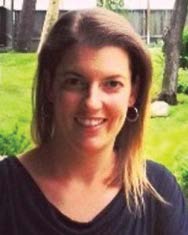
THE FITNESS PRIORITY My name is Kristin McNealus, DPT, MBA, and I received my Masters in Physical Therapy from Boston University and went on to earn my Doctorate in Physical Therapy from MGH Institute of Health Professions. I received my MBA from Pepperdine University in 2016. I started Every Body fitness, an online fitness program for people with physical limitations to workout anywhere. We have a video-ondemand program that offers cardiovascular workouts, boot camp style strengthening workouts, balance classes, and adapted yoga programs. I started this because I know that it is important to get exercise, but there can be challenges getting out to some of the activities discussed in this article. I wanted to design an option with as few barriers as possible. This can be a primary workout program, or complement any other activities. you can check this program out at ebfitnessonline.com
If you have limb loss, you can look to the Amputee Coalition for guidance on how to stay active. amputee-coalition.org/limb-loss-resource-center